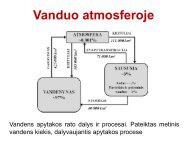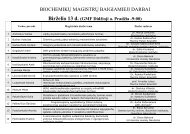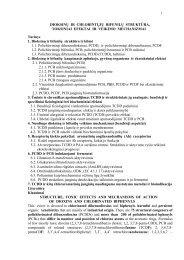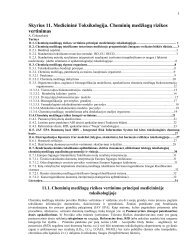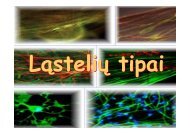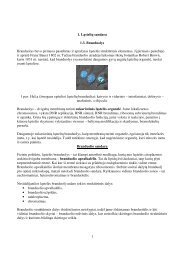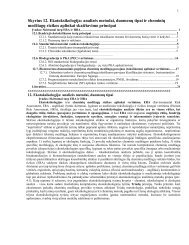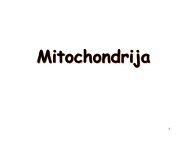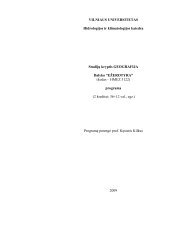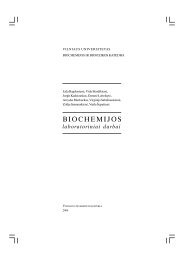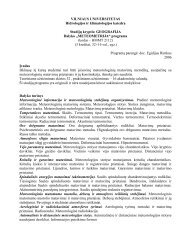492 CHAPTER TWENTY-FOURVariation in Speciation RatesSome lineages <strong>of</strong> organisms have many species; others haveonly a few. Hundreds <strong>of</strong> species <strong>of</strong> Drosophila evolved in theHawaiian Isl<strong>and</strong>s, but there is only one species <strong>of</strong> horseshoecrab, even though its lineage has survived for more than 300million years. Why do rates <strong>of</strong> speciation vary so widelyamong lineages?A number <strong>of</strong> factors are known to influence speciationrates:<strong>Species</strong> richness. The larger the number <strong>of</strong> species in a lineage,the larger the number <strong>of</strong> opportunities for newspecies to form. For speciation by polyploidy, the morespecies in a lineage, the more species are available tohybridize with one another. For allopatric speciation, thelarger the number <strong>of</strong> species living in an area, the largerthe number <strong>of</strong> species whose ranges will be bisected bya given physical barrier.Dispersal rates. Individuals <strong>of</strong> species with poor dispersalabilities are unlikely to establish new populations by dispersingacross barriers. Even narrow barriers are effectivein dividing species whose members are highlysedentary.Ecological specialization. Populations <strong>of</strong> species restrictedto habitat types that are patchy in distribution are morelikely to diverge than are populations that occupy relativelycontinuous habitats.Population bottlenecks. The changes in gene pools that<strong>of</strong>ten occur when a population passes through a bottleneckmay result in new adaptations.Type <strong>of</strong> pollination. Speciation rates in plants are correlatedwith pollination mode. Animal-pollinated plant familieshave, on average, 2.4 times as many species as closelyrelated families pollinated by wind. In addition, theswitch from animal to wind pollination is strongly associatedwith a reduction in the rate <strong>of</strong> speciation in a lineage.Sexual selection. Animals with complex behavior are likelyto form new species at a high rate because they makesophisticated discriminations among potential matingpartners. They distinguish members <strong>of</strong> their own speciesfrom members <strong>of</strong> other species, <strong>and</strong> they make subtlediscriminations among members <strong>of</strong> their own species onthe basis <strong>of</strong> size, shape, appearance, <strong>and</strong> behavior (seeFigures 23.16 <strong>and</strong> 23.17). Such discriminations can greatlyinfluence which individuals are most successful inproducing <strong>of</strong>fspring <strong>and</strong> may lead to rapid reinforcement<strong>of</strong> reproductive isolation between species.Environmental changes. Oscillations <strong>of</strong> climates may fragmentpopulations <strong>of</strong> species that live in formerly continuoushabitats.Number <strong>of</strong> new antelope speciesappearing in the fossil record201510504 3 2 1Millions <strong>of</strong> years agoAfrican antelopes provide a striking example <strong>of</strong> the influence<strong>of</strong> climate change on speciation rates. These animals experienceda burst <strong>of</strong> speciation <strong>and</strong> extinction between 2.5<strong>and</strong> 2.9 mya. During that period, the number <strong>of</strong> known antelopespecies doubled, <strong>and</strong> 90 percent <strong>of</strong> all known specieseither first appeared or became extinct (Figure 24.15). Thisburst coincided with a shift in Africa from a warm, wet climateto one that oscillated between warm <strong>and</strong> wet <strong>and</strong> coolerbut drier conditions. During this period, grassl<strong>and</strong> <strong>and</strong> savannaenvironments increased <strong>and</strong> decreased, repeatedly coalescing<strong>and</strong> separating over much <strong>of</strong> Africa as the climateoscillated. The burst <strong>of</strong> speciation among antelopes resultedin many new species adapted to these environments.Evolutionary RadiationsMany new speciesappeared 2.5–2.9 mya.24.15 Climate Change Drove a Burst <strong>of</strong> Speciation amongAntelopes The excellent fossil record <strong>of</strong> African antelopes revealsthat there was a sudden burst <strong>of</strong> speciation between 2.5 <strong>and</strong> 2.9 millionyears ago. At that time, the climate <strong>of</strong> Africa shifted from beingconsistently warm <strong>and</strong> wet to oscillating between warm <strong>and</strong> wet <strong>and</strong>cool <strong>and</strong> dry.The fossil record reveals that, at certain times in certain lineages,speciation rates have been much higher than extinctionrates. The result is the proliferation <strong>of</strong> a large number <strong>of</strong>daughter species, as happened with finches in the Galápagosarchipelago (see Figure 24.6). Such an event is called an evolutionaryradiation. What conditions cause speciation ratesto be much higher than extinction rates?Evolutionary radiations are likely when a population colonizesa new environment that contains relatively fewspecies. As we saw in Chapter 22, evolutionary radiations occurredin many lineages on continents following mass extinctions.Evolutionary radiations occur on isl<strong>and</strong>s becauseisl<strong>and</strong>s lack many plant <strong>and</strong> animal groups found on themainl<strong>and</strong>. The ecological opportunities that exist on isl<strong>and</strong>smay stimulate rapid evolutionary changes when a newspecies does reach them. Water barriers also restrict geneflow among the isl<strong>and</strong>s in an archipelago, so populations on
SPECIES AND THEIR FORMATION 49324.16 Rapid Evolution among HawaiianSilverswords The Hawaiian silverswords, threeclosely related genera <strong>of</strong> the sunflower family, arebelieved to have descended from a single commonancestor, similar to the tarweed (Madia sativa), thatcolonized Hawaii from the Pacific coast <strong>of</strong> NorthAmerica. The four plants shown here are moreclosely related than they appear to be based ontheir morphology.Madia sativa (tarweed)Argyroxiphium s<strong>and</strong>wicenseDubautia menziesiiWilkesia hobdyidifferent isl<strong>and</strong>s may evolve adaptations to their local environments.Together, these two factors make it likely that speciationrates <strong>of</strong> newly colonizing lineages on isl<strong>and</strong> archipelagoeswill exceed extinction rates.Remarkable evolutionary radiations have occurred in theHawaiian Isl<strong>and</strong>s, the most isolated isl<strong>and</strong>s in the world. TheHawaiian Isl<strong>and</strong>s lie 4,000 km from the nearest major l<strong>and</strong>mass <strong>and</strong> 1,600 km from the nearest group <strong>of</strong> isl<strong>and</strong>s. The nativebiota <strong>of</strong> the Hawaiian Isl<strong>and</strong>s includes 1,000 species <strong>of</strong>flowering plants, 10,000 species <strong>of</strong> insects, 1,000 l<strong>and</strong> snails,<strong>and</strong> more than 100 bird species. However, there were no amphibians,no terrestrial reptiles, <strong>and</strong> only one native mammal—abat—on the isl<strong>and</strong>s until humans introduced additionalspecies. The 10,000 known native species <strong>of</strong> insects onHawaii are believed to have evolved from only about 400 immigrantspecies; only 7 immigrant species are believed to accountfor all the native Hawaiian l<strong>and</strong> birds.More than 90 percent <strong>of</strong> all plant species on the HawaiianIsl<strong>and</strong>s are endemic—that is, they are found nowhereelse. Several groups <strong>of</strong> flowering plants have more diverseforms <strong>and</strong> life histories on the isl<strong>and</strong>s, <strong>and</strong> live in a widervariety <strong>of</strong> habitats, than do their close relatives on themainl<strong>and</strong>. An outst<strong>and</strong>ing example is the group <strong>of</strong> Hawaiiansunflowers called silverswords (the genera Argyroxiphium,Dubautia, <strong>and</strong> Wilkesia). Chloroplast DNA sequencesshow that these species share a relatively recent commonancestor with a species <strong>of</strong> tarweed from the Pacific coast <strong>of</strong>North America (Figure 24.16). Whereas all mainl<strong>and</strong> tarweedsare small, upright, herbs (that is, nonwoody plants),the silverswords include prostrate <strong>and</strong> upright herbs,shrubs, trees, <strong>and</strong> vines. Silverword species occupy nearlyall the habitats <strong>of</strong> the Hawaiian isl<strong>and</strong>s, from sea level toabove timberline in the mountains. Despite their extraordinarymorphological diversification, however, the silver-



